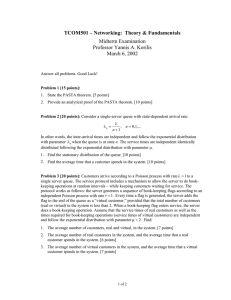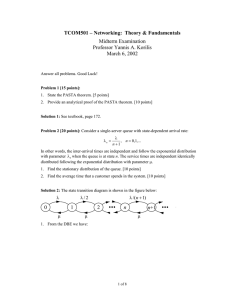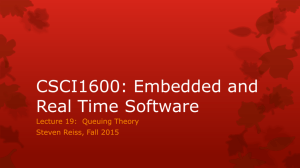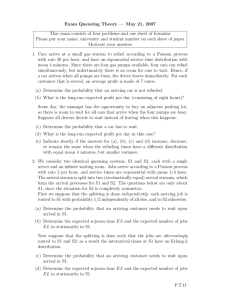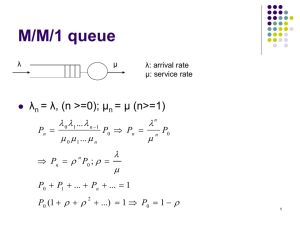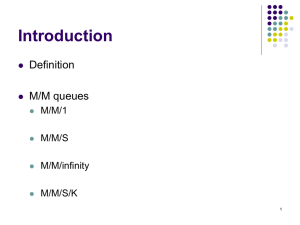Deducing Queueing From Transactional Revisited by
advertisement
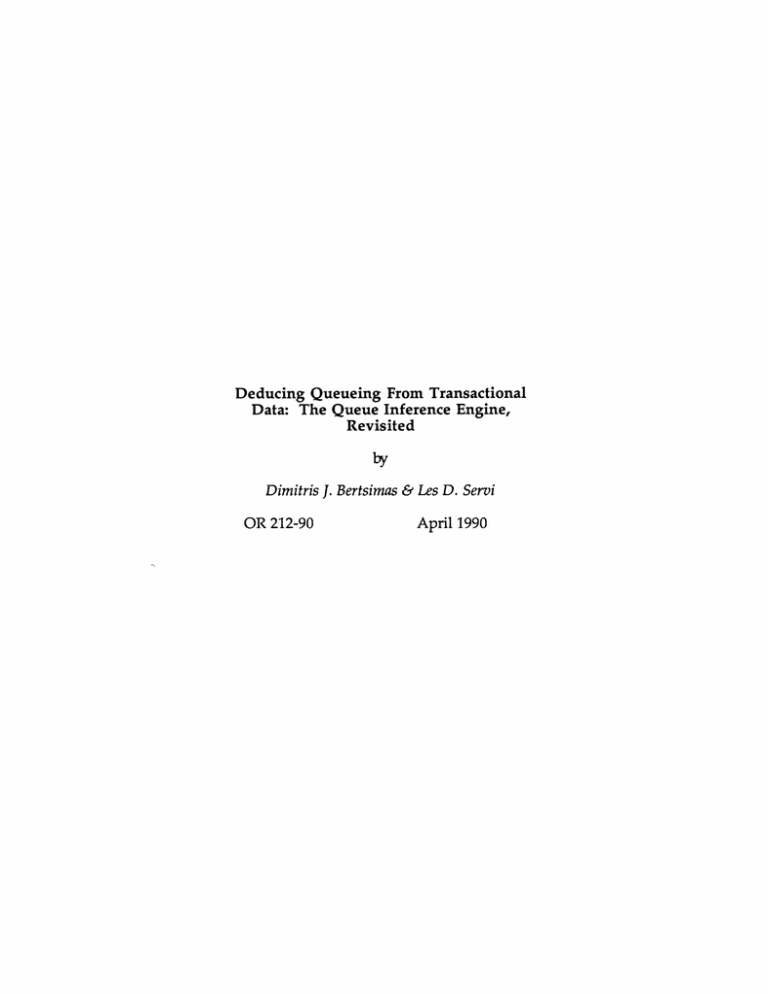
Deducing Queueing From Transactional
Data: The Queue Inference Engine,
Revisited
by
DimitrisJ. Bertsimas & Les D. Servi
OR 212-90
April 1990
Deducing Queueing from Transactional Data: the Queue
Inference Engine, Revisited
Dimitris J. Bertsimas *
L. D. Servi t
April 11, 1990
Abstract
Larson [1] proposed a method to statistically infer the expected transient
queue length during a busy period in
0(n
5
) solely from the n starting and
stopping times of each customer's service during the busy period and assuming
the arrival distribution is Poisson. We develop a new O(n3 ) algorithm which
uses this data to deduce transient queue lengths as well as the waiting times
of each customer in the busy period. We also develop an O(n) on line algorithm to dynamically update the current estimates for queue lengths after each
departure. Moreover we generalize our algorithms for the case of time-varying
Poisson process and also for the case of iid interarrival times with an arbitrary distribution. We report computational results that exhibit the speed and
accuracy of our algorithms.
*Dimitris Bertsimas, Sloan School of Management and Operations Research Center, MIT, Rm.
E53-359, Cambridge, Massachusetts, 02139.
tL. D. Servi, GTE Laboratories Incorporated, 40 Sylvan Road, Waltham, Massachusetts, 02254.
This work was completed while L. D. Servi was visiting the Electrical Engineering and Computer
Science Department of MIT and the Division of Applied Sciences at Harvard University while on
sabbatical leave from GTE Laboratories.
1
1
Introduction
In 1987, Larson proposed the fascinating problem of inferring the transient queue
length behavior of a system solely from data about the starting and stopping time of
each customer service. He noted that automatic teller machines (ATM's) at banks
have this data, yet they are unable to directly observe the queue lengths. Also in
a mobile radio system one can monitor the airwaves and again obtain times of call
setups and call terminations although one is unable to directly measure the number
of potential mobile radio users who are awaiting a channel. Other examples include
checkout counters at supermarkets, traffic lights, and nodes in a telecommunication
network. More generally, the problem arises when costs or feasibility prevents the
direct observation of the queue although measurements of the departing epochs
are possible. This paper discusses the deduction of the queue behavior only from
this transactional data. In this analysis no assumptions are required regarding the
service time distribution: it could be state-dependent, dependent on the time of day,
with or without correlations. Furthermore, the number of servers can be arbitrary.
In Larson [1] two algorithms are proposed to solve this problem based on two
astute observations: (i) the beginning and ending of each busy period can be identified by a service completion time which is not immediately followed by a new service
commencement; (ii) a service commencement at time t implies that the arrival time
of the corresponding customer must have arrived between the beginning of the busy
period and ti. Furthermore, if the arrival process is known to be Poisson, then the
a posteriori probability distribution of the arrival time of this customer must be
uniformly distributed in this interval. In Larson [1] these observations are used to
derive an O(n5 ) and an 0(2 n ) algorithm to compute the transient queue lengths
during a busy period of n customers.
In this paper we propose an O(n3 ) algorithm, which estimates the transient
queue length during a busy period as well as the delay of each customer served
during the busy period. Moreover, we generalize the algorithm for the case of time-
2
varying Poisson process to another O(n 3 ) algorithm and also find an algorithm for
the case of stationary interarrival times from an arbitrary distribution.
We also
develop an O(n) on line algorithm to dynamically update the current estimates for
queue lengths after each departure. This algorithm is similar to Kalman filtering
in structure in that the current estimates for future queue lengths are updated
dynamically in real time.
The paper is structured as follows: In Section 2 we describe the exact O(n 3 )
algorithm and prove its correctness assuming the arrival process is Poisson.
In
Section 3 we generalize the algorithm for the case of time-varying Poisson process
into a new O(n 3 ) algorithm. In Section 4 we further generalize our methods to handle
the case of an arbitrary stationary interarrival time distribution. In Section 5 we
describe the algorithm to dynamically update queue lengths in real time. In Section
6 we report numerical results. We also examine the sensitivity of the estimates to
the arrival process.
2
Stationary Poisson Arrivals
In this section we will assume that the arrival process to the system can be accurately
modeled as a Poisson process with an arrival rate that it is unknown but constant
within a busy period. The arrival rate, however, could vary from busy period to busy
period. In sections 3 and 4 this assumption is relaxed. We consider the following
problem: Given only the departure epochs (service completions) ti, i = 1,2,..., n
during a busy period in which n customers were served, estimate the queue length
distribution at time t and the waiting time of each customer. As we noted before
we make no assumptions on the service time distribution or the number of servers.
2.1
Notation and Preliminaries
The following definitions are needed. Let
3
1. n = the number of customers served during the last busy period (the end of
the busy period is inferred from a service completion that is not immediately
followed by a new service commencement).
2. ti = the time of the ith customer's service completion.
3. Xi = the arrival time of the ith customer.(By definition X1 < X 2 ... < Xn. )
4. N(t) = the cumulative number of arrivals t time units after the current busy
period began.
5. Q(t) = the number of customers in the system just after t time units after the
current busy period began.
6. D(t) = the cumulative number of departures t time units after the current
busy period began.
7. Wj = the waiting time of the jth customer.
8. O(t-) = the event {X 1
tl,...
,
< tn}
9. O'(i, n) = the event {X 1 < tl,. .. ,Xn
,<
t, and N(tn) = n}.
Without loss of generality assume that the busy period starts at time to = 0.
We observe the process D(t) and wish to characterize the distribution of N(t)
given D(t). From N(t) properties of Q(t) and Wj can be directly computed. For
example Q(t) = N(t)- D(t). Suppose exactly n - 1 consecutive service completions
coincide with new service initiations at times tl,t 2,. .. ,tn,
tion takes place at time t
1,
and a service comple-
without a simultaneous new service initiations. Then,
one knows that event O'(,n) occurred, i.e., X1 < t,...,Xn < t and N(tn) = n.
We want to compute the distribution of N(t) conditioned on O'(i, n).
To do this we note (Ross [3]) that the conditional joint density for 0 < x 1 <
X2 ..
< Xn
f(X = xi,
,Xn=
'lN(xn)
= n)
Zn
4
(1)
As a result,
n
tlN(tn) = n} = -n!
Pr{Xi < tl,..., Xn
ntl=O
-0
2
2=
j
dxl ... dxn
n=n-1
1
(2)
Equation (2) is an example of an integral that encapsulates the a posteriori information of the arrivals times. This information combined with the known departures
times lead to a posteriori estimates of the queue lengths and waiting times. More
generally, as will be shown in Section 2.2 and proven in Section 2.3 to evaluate this
type of integral efficiently we must evaluate the following related integrals
Hj,k(y)=
j
f
J
...
Hl=O
12-l
j=
.
dxl
j1+l=Xj
k
. .dxk
.
(3)
Xk1
and
L
:J
Fk(y) =
k=O
dxk ... d
...
J'k+l=xk
(4)
-n=n-
at y = tj.
Define
t2
fti
hj,k = Hj,k(tj) =
Jl 1=OJ
...
i
ft j
fj
J=jl=
2=X 1
ftj
...
j+l=j
I
dx
. . dxk
(5)
Xk=Xk-l
and
fj,k = Fk(tj)=
k=
0
ft
dk+l
=k
dXk... d.
(6)
:n=n-1
The first four steps of the following algorithm will compute these values in O(n 3)
and the next two steps will use these values to compute transient queue length and
waiting time estimates. The validity of the algorithm will be demonstrated in Section
2.3.
2.2
An exact O(n3 ) Algorithm
STEP 0 (Initialization).
Let
ho,o = 1,fn+l,n+l =
5
1
,to = 0
(7)
STEP 1 (Calculation of the diagonal elements hk,k).
For k = 1 to n,
k
kitk-i+l1
hk,k = E(-1)k-i
ti+
-
(8)
)! hi-1,i-1.
(9)
1
STEP 2 (Calculation of hj,k).
For j = 1 to n - 1
For k = j + 1 to n,
hk-hjk t
-(k
i +l
(tj - t)i- k-
i=1
(k
-
)!
STEP 3 (Calculation of the diagonal elements fk,k).
For k = n to 1,
n
i-k+l
fk,k = Z(-1)i - k
i=k
(i- k + 1)!'
STEP 4 (Calculation of
k
+
(10)
fii+i
fj,k).
For j = 1 to n - 1
For k = j + 1 to n,
ti-k+l
n
fj,k =
-- 1)ik
j
(i-
i=k
k + 1)!
f+i+i
'
f
(11)
STEP 5 (Estimates of transient queue length).
1. For j = 1 to n - 1
E[Q(tj) O'(i, n)] =
2. Given t, tj
_k=j khj,k[fk+l,k+l - fj,k+l]
h,n
(12)
t < tj+l
E[Q(t)O'(i,n)] = E[Q(tj+1 )Ot'(i, n)] + (1 -
)E[Q(tj) O'(t n)]
(13)
= Hj,k+j(t)[Fk+j+l(tk+j+l)- Fk+j+l(t)]
(14)
where 0 = t-tj and for 0 < k < n-l-j
Pr{Q(t) = kOt( n)}
hrn
6
and
Pr{Q(t) = OIO'(t, n)} = 1
(15)
where
Hj,k(y) =
k
(y_
i(k!
ti)k-i+l h_(16)
(k+1)
hi- i1
and
Fk(y)
=E
()i--k + l)
f+l,+i
(17)
where ho,o and fn+l,n+l are defined in (7).
STEP 6 (Estimates of transient waiting time).
For tj < tk - t < tj+1
Pr{Wk < tlO'(fin)} = Er=l Hj,r(tk - t)[Fr+l(tr+l)- Fr+l(tk - t)]
(18)
where Hj,k(y) and Fk(y) are defined in (16) and (17), respectively.
From the first four steps of the algorithm all of the hj,k's and fj,k 's can be
found in O(n3 ). From (13), to compute E[Q(t)10'(, n)] for only one value of t can
be done in O(n2 ) because not all hj,k's and fj,k's are required. However, from (13),
to compute E[Q(t) O'(i,n)] for all values of t requires O(n3 ) with the bottleneck
steps being STEP 2 and STEP 4. To speed the implementation of the algorithm,
for j = 1,2,..., n, j! should be computed once and stored as a vector. Also, note
that the fj,k's and hj,k's need not be stored but instead can be computed and
then immediately used in equation (12) to reduce the storage requirements of the
algorithm to O(n).
2.3
Proof of Correctness
In this subsection we prove that indeed the algorithm correctly computes the distributions of the queue length and waiting time. A basic ingredient of the analysis
is the following lemma that simplifies the multidimensional integrals:
7
Lemma 1
// :
...
dxl
. dxk =
.
(19)
k!
:rk=Xk-1
Z1=Z J2=X1
Proof: (by Induction).
For k = 1 (19) is trivial. Suppose (19) were true for r = k. Then, from the induction
hypothesis
1i=Z
. . ..
(Y
dxl...dxk+l
Lk+l
- 2=jXl
z)k
kT
1=Z
=k
dxl = (
+ 1)kl
(k
+
1).
Hence, (19) is true for r=k+1 and the Lemma follows by induction. O
Remark: The proof of Lemma 1 can be generalized to show that
>
~1
=Z
2='"1
.J.>
. iY
xk=
k-1
f(xk)dxl
y
... dxk=
1
=Z
(Y
xl)klf(xl)dx.
(
-)
(20)
In the following proposition we justify steps 1 and 2 of the algorithm.
Proposition 2 STEP
and STEP 2 of the algorithm are implied by the definition
of hj,k. Also Hj,k(y) defined in (3) satisfy (16).
Proof: If we apply lemma 1 to (3) we obtain
Hj,k ()
=
fxtj
(Y -
lt2j
I=
)k-j
dxl...dx3 ,
(Y-X
j
j=j-
2=
(k-j)
which, after performing the innermost integral, is equal to
ftl
z=0
jt
2
2=1
tj-1
j1=X-2
[(Y
( _ tj)k-j+l
-Xj-)k-j+l
(k-
j + 1)!
(k - j + 1)! ]
Hence, from (3) and (21) we obtain
Hj,k(y) = Hjl,k(y)
-
-
(k-j
j)+
+ 1)!
1
Successive substitution of this equation gives,
Hj,k(y) = H1,k(y)
(i=2 (k
8
)+- '
-i-]1)i
1
li1
(21)
But from (3)
i
Hlk(y) =
'..
-i)!
(k0=o
1
(y - tl)k
dx = Yk
(Y - xl)k-
k!
and thus (16) follows. Since hj,k = Hj,k(t), (9) is obtained. Moreover, from (5) and
(21), hk,k = Hk,k(O) and thus we obtain (8). 0
We now turn our attention to the justification of steps 3 and 4 of the algorithm.
Proposition 3 STEP 3 and STEP 4 of the algorithm are implied by the definition
of fj,k in (6). Also Fk(y) defined in (4) satisfy (17).
Proof: From (4) we note that Fk(y) is a polynomial in y of degree n-k + 1. Let ci,k
-i
be the coefficients in Fk(y) = Ei=k Ck,i-k+ly
k+l.
y
Moreover, from (4) we obtain:
F
Fk(Y ) =-
[Fk+l(tk+l)- Fk+l(xk)]dx k.
By differentiating,
dFk (y)
dy
-
(22)
Fk+l(tk+l)- Fk+l(Y)
and
d2 Fk(y) _
dy 2
dFk+l(y)
dy
More generally,
di- k+l Fk(y)
dy
-
(
1 )i
k+ l
d(y)
k
dy
-
From Taylor's Theorem, ck,i-k+l = d'-k+lrk(O)
d~YTk+
l
/(i
-
k + 1)! and Ci,1 =
df (0)
There-
fore,
(-_ l)i-k
k + 1)!Ci
Cki-k+1 = (i-
(i - k + 17~~~~~23
Evaluating (22) at y = 0 gives
Ck,1 =
dFk()
dy
= Fk+l(tk+1),
since Fk+1(0) = O. As a result,
n
Ck-1,1 = Fk(tk) =
Ckii=k
9
ik+
l
(23)
From (23),
_Ckl,1
n (-1)i-kti - k+ 1
i=k (i
where cn,1 = 1. Thus, fk,k = Fk(tk) =
~
k + 1)!
Ck-l,1
satisfy (10). In addition, Fk(y) =
~(_l)i-kti-k+1
ni=k ck,ik+li k+l, which from (23) is Z=k
(i-k+l)! ci,1 and thus (17) follows.
yi-k·n
l,
Moreover, since fj,k = Fk(tj), (11) follows.
Having established the validity of the steps of the algorithm required to compute
the hj,k's and fj,k's we proceed to proof the correctness of the performance measure
parts of the algorithm, steps 5 and 6.
Theorem 4 The distribution of Q(t) and its mean conditioned on the observations
O'(t, n) is given by (12), (13),(14) and (15) in STEP 5 of the algorithm.
Proof: For n- 1 > k > j and tj < t < tj+l the event {N(t) = k, O(t)} occurs if
and only if 0 < X 1 < tl,...,Xjl < Xj < tj,Xj < Xj+ < t,...,Xk-l < Xk <
t,t < Xk+l < tk+l, ... ,Xn-
< Xn < tn. Since the arrival process is Poisson, the
conditional density function is uniform and hence,
Pr{N(t) = k,O(tlJN(tn) = n} =
n
ttl
tn Jz1=0
tj
t
t
rtk+
j
-=zj
1 Jzj+l=zj
J2k=zk_
J1dk+i=t
tn
-- d .....dn,
n=n-
which, from (3) and (4), is
n!
-Hj,k(t)[Fk+l(tk+l)n
Fk+l(t)].
Similarly, from (2) and (5),
Pr{O(tIlN(tn) = n} = n! Jtlt2
n 1l=0
Therefore, for n - 1 > k > j and tj
Z2= Z
.
Z=-tn
dx
...
dx
= n-h,
nt
f
t < tj+l
Pr{N(t) = klO(t),N(tn) = n} = Hj,k(t)[Fk+l(tk+l)- Fk+l(t)]
10
(24)
For t = tj, using (5) and (6), we have
= hj,k[fk+l,k+l -
Pr{N(tj) = klO(t, N(t~) = n
(25)
fj,k+l]
hnn
Since Q(t) = N(t)-
D(t) and D(tj) = j
E[Q(tj)1O(ti, N(tn) = n] = E[N(tj)10(t, N(tn) = n]- j
n
=
k=j
kPr(N(tj) = klO(tO, N(tn) = n}- j
because, for k < j, Pr{N(tj) = klO(t), N(tn) = n} = 0. Hence, (12) follows from
(25). Also, for tj < t < t+j,
Pr{Q(t) = klO(t, N(tn) = n} = Pr{N(t) = j + kjO(t, N(tn) = n}
so (14) follows from (24). In addition, (15) follows from the observation that N(tn) =
D(tn) = n with probability 1 and Q(t) = N(t)-
D(t).
Suppose we condition on the event {N(tj) = r and N(tj+1 )} = m. Then, for
tj
t < tj+l,
Pr{N(t) =
klO(t), N(t,) = n, N(t j ) = r, N(tj+l) = m} =
Pr{N(t) = k, N(tj) = r, N(tj+l ) = m, O(t) IN(tn)
n}
Pr{N(tj) = r, N(tj+l) = m, O(t), IN(tn) = n}
tl
1
1
tj
=O
1
tj
Zj=Xj-1
frotl
xl=-O
t
fr=r-l
it
fr+l=tj
rtj =xrft>Xp._X
--
f
_fZr+l=tj
Xkfkl=
r+1
',+l
t j+l=
.'
f
,+
+
=x-1 Jz +l=tj+l
f=m.1
f+m1:=
j+l
At+l
n
fxm=?m- lm+l=t+
tj+
f
k
tj+1
fkilt
k=xk1
1
dx
tn
iXn=xn-I
1 .d
dzr+l... dm
dxrll dd
....
d2,+,1 ... dzm
t+1
after simplification. Using Lemma 1 and some additional simplification we obtain
Pr{N(t) = klO(tI), N(tn) = n, N(tj)
where
=
r, N(tj+1 ) = m}
= (k-r)k-
= tj+l-tj
tj
Hence,
Pr{N(t)
- N(tj) = k'IO(t,
N(tn) = n,
11
N(tj), N(tj+l)}
( -O)
dZ
dx 1 .dn
n=n-,
k
(N(tj+l)- N(tJ)) k'(1 _ O)N(tj+l)-N(tj)
(26)
Therefore, N(t) conditioned on N(tj) and N(tj+1 ) is a Binomial distribution so
E[N(t)1O(t, N(t.) = n, N(tj), N(tj+1 )] = N(tj) + O(N(tj+) - N(tj)),
which by taking expectations leads to
E[N(t)O(t), N(tn) = n] = (1 - O)E[N(tj)] + OE[N(tj+1 )]
Since Q(t) = N(t) - j for tj
t < tj+l the piecewise linearity of (13) follows.
Remark: Larson [1] also contains a proof of the piecewise linearity of E[N(t)10(t), N(tn) =
n]. Our proof more easily generalizes to the case of time varying arrival rates.
Finally, we establish the correctness of STEP 6 of the algorithm.
Theorem 5 The distribution of W(t) conditioned on the observations O'(, n) is
given by (18) in STEP 6 of the algorithm.
Proof: The total time Wk the kth customer spent in the system is simply tk - Xk.
Therefore, the event {Wk
t} is the same as the event {Xk
the same as the event {N(tk
-
t)
tk - t}. But this is
k}. Hence,
k
Pr{Wk
tlO'(, n)} = Pr{N(tk-t)
kO'(F,n)) = Z
Pr{N(tk-t) = iO'(, n)),
i=l
so (18) follows from (24).
Note that (13) and (18) provides the basis to easily compute higher moments of
W(t), and Q(t).
3
The Time-Varying Poisson Arrival Process
In the previous section we assumed that the arrival rates are Poisson with a hazard
rate A that is constant during each busy period and found the inferred queue length
and waiting time. In some applications, however, it is not realistic to assume that
12
A remains constant. We will show in this section that all the results of the previous
section are immediately extendible to this case without adding any complexity to the
resulting algorithm. In particular, if the arrival rate is time-varying, A(t) > O, then
we will show that the algorithm in Section 2.2 is applicable if all t 's are replaced by
fot A(x)dx.
Let A(t) be the time-varying arrival rate. We will first need to find the generalization of the conditional distribution of the order statistics given in (1).
Theorem 6 Given that N(t) = n and the time-varying arrival rate A(t), the conditional density function of the n arrival times
f(X = ,.,Xn
X ,...
2,
= nlN(t) = n)=
X
is
n!-i A(xi)
A(
i)
An (t)
(27)
where A(t) = fot A(x)dx.
Proof: The proof below is similar to Theorem 2.3.1 of Ross [3]. Let 0 < x1 < x2 <
. . Xn < Xn+1 = t, and let ei be small enough so that xi + ei < xi+, i = 1,..., n.
Now, Pr{x1 < X 1 < x1 +
1 ,...,x,
< X, _<
Xn
+ en and N(t) = n} = Prexactly
one arrival in [xi, xi + ei] for i < n and no arrival elsewhere in [0, t]}.
But the number of Poisson arrivals in an interval I is Poisson with a mean
fxEI A(x)dx, so the above probability is
n
n
JJ[e-MiMi]e-(A(t>
il M)) = eA(t)
i=1
where Mi =
xl+'I
I|
Mi
i=l
A(x)dx = A(xi)ei + o(i)
Since Pr{N(t) = n} = e-(t)A)
(27) follows. J
Given that we have now characterized the joint conditional density we can answer
questions about the system behavior.
Proposition 7 Suppose A(t) > O. Let tj < t < tj+1 . Then
n! A()
Pr{X1 < tl, . . Xn < tN(tn) = n
f(t2)
...
(tn)
dxl ... dxn
=
(28)
13
Proof
From (27),
1=0
Pr{X1 < tl,. .. ,Xn < tN(tn)
= n} =
ft2=l ... ft=_
H=l
A(xi)dx
l
...
dxn
2=n=n-
A(tn)n
(29)
Consider now the transformation of variables yi = A(xi), i = 1,
n. This is an one-
to-one monotonically increasing function if A(t) > 0. Furthermore dyi = A(xi)dxi.
With this transformation of variables all of the upper limits change from xi = ti to
yi = A(ti). But the condition xi = xi- 1 is equivalent to yi = yi-1. Performing the
transformation of variables we obtain (28).0
The proof of above proposition leads to a very simple extension of the algorithm
of the previous section.
Theorem 8 STEPS 1-6 of the algorithm of Section 2.2 are valid for time varying
A(t) if replace t is replaced by A(t) ( and tj with A(tj)).
Proof: This theorem follows immediately by applying the original proofs of STEPS
1-6 to the time varying case and using the transformation of variables yi = A(xi) as
was done in the above proposition. O
Remark: Note that the piecewise linearity property with respect to t of E[Q(t)lO'(t, n)]
in equation (13) found for the case of constant A is destroyed by the transformation
of variable, i.e., E[N(t)lO'(F,n)] = (1 - O)E[N(tj)IO'(F,n)] + OE[N(tj+ )IO'(t
where 0
=
n)]
A(t)-A(tj)
Note that while, the performance measures in the homogeneous Poisson case
of the previous section do not depend on the knowledge of A, the results in the
time-varying case require knowledge of A(t).
4
Stationary Renewal Arrival Process
Our methods in the previous sections critically depended on the Poisson assumption.
In this section this assumption is relaxed and we only assume that the arrival process
14
is a renewal time-homogeneous process, where the probability density function between two successive arrivals is a known function f(x) and c.d.f. F(x) = fy=O f(y)dy.
The key step is to generalize (2):
Theorem 9
tl,...,
Pr{Xl
rl=0
t
Xn
IN(tn) = n} =
f(xl)f(2 - Xl)... f(xn - Xn-1)( 1 - F(t - xn))dxl ... dxn
rn=-
F(n)(tn)- F(n+l)(tn)
(30)
Proof: The underlying conditional density function can be expressed in terms of
the ratio i.e.,
h(Xi = x 1 ,...
X
,Xn = xnlN(t) = n) =
But g{X1 = x1,...,
Xn = Xn,
=
Pr{N(t) = n}
N(t) = n
N(t) = n} is the joint density function corresponding
to the first interarrival time being xl, the second interarrival time being x 2 - xl,...,
the the nth interarrival being xn- xn-1,and having no arrival occurred in an interval
of duration t - xn. Hence,
g{X 1 = xi,... ,Xn = xn,N(t) = n}
... f(xn-Xn-1)(1-F(t-n)).
= f(xl)f(x 2 -Xl)
Also,
Pr{N(t) = n} = Pr{N(t) < n}-Pr{N(t) < n-1} = Pr{Xn+l > t)}-Pr{Xn > t)}
= F(n)(t)-
F(n+l)(t),
where F(n)(t)is the cdf of the nth convolution of the renewal process and F(x) =
fo f ()dx
so
h (X
xi,...= , Xn
=
xnf N (t) =
f()f(2 -
f(xn - x,- 1 )(1 - F(t - x))
Fh(X
(n)(t)n)
F(n+l)(t)
(...
)
(31)
so (30) follows. 0
15
Equation (30) is the basis of the algorithm for estimating Q(t) and W(t).
For example, using (30), one can evaluate
Pr{N(tj) > kO(t), N(tn) = n}
Pr{X1 < t, .. ., Xj < tj,Xj+l tj,... Xk tj, Xk+l < tk+l,
Xn, t IN (tn) = n}
Pr{X1 < tl,...,Xj < tj,Xj+l tj+l,...,Xk < tk,...,Xk+l < tk+l, . .. ,Xn < tlN(tn) = n}'
(32)
From (32), one can find
E[Q(tj)lO(t), N(tn) = n] = E[N(tj) > kO(t), N(tn) = n]-
j
because Q(tj) = N(tj)- j.
n
= E PrfN(tj) > klO(tt, N(t) = n} -j
k=l
n
= E Pr N(tj) > kO(t, N(tn) = n}k=j
because Pr{N(tj) > kO(t, N(tn) = n} = 1 for k = 1,2,.., j-
1.
For the Erlang-k distribution, for example, f(x) = A(AX)k-le-Ax/(k - 1)! and
F(x) = 1- e
(Ax)3/j!.
In this case, from (30), for allt l ,t 2,...,t,
Prt{X1
tl, .. . ,Xn < tlN(tn) = n}
k-1
= Ak(A,tn)
10
X1=0
Xk-l(2-X
....
J.
1 )k
- 1
..
.
(Xn-Xnl)k-1
n=8n-1
(A(tn-xn)
)3/j!dxl . ..dxn
j=O
(33)
where
Ak(A,t)
=
(Ak/(k-
1)!)e-,t-
F(n)(t)- F(n+l)(tn)'
Therefore, the evaluation of (32) can ignore the contribution of Ak(A, tn) because it
will cancel in the numerator and denominator.
16
5
Realtime Estimates
In some applications it is desirable not to wait until the end of a busy period to
estimate the queue length. For example, if there is a possibility of realtime control
of the service time, knowledge that the queue length was excessively large but it is
currently zero is not of value. Instead a current estimate is needed. The analysis of
this problem will be derived for the case of a time-varying Poisson process. However,
for the case of a constant arrival rate the method can be easily specialized.
Suppose that immediately after the nth departure (time t + ) we observe exactly n
departures at times ti, i = 1, 2, ... , n during a busy period and the busy period did
not end at time tn (as inferred from the commencement of a new service initiation
at time tn). We are interested in having an estimating the state of the system at
time t > tn without any observation of D(t) between time tn and time t. Also
note that knowledge that the busy period did not end at time tn is equivalent to
Xn+ 1 < tn. The following theorem provides the basis for an O(n) on line algorithm
for estimating N(t) and Q(tn) given these observations.
Theorem 10 Let tn be the time we observe the system. Then, for t > tn,
E[N(t)lO(t, X+
1
< t,] = 1n
+ A(t)
(34)
and
E[Q(tn)iO(t), Xn+l < tn] = 1 + A(tn)-
Rn
Tn
(35)
where
and qn,p,,
Rn = qn + Pn - [A(tn) + 1]e-A(tn)gn,
(36)
Tn = Pn - e-A(tn)gn,
(37)
gn are computed as follows:
qn = qn- 1 + Pn-1 - [A(tn) + 1]ePn = Pn-1 - eA(tn)g n -
17
(tn)gn - 1 ,
1
A
(38)
,
(39)
and
k
gk = E(_lk-i k
Ak-i+l(t,)
(ti
i
(40)
with the initial conditions po = 1, qo = O,go = 1.
Proof: For j > n + 1, using (27),
PrO(t), Xn+l < tlN(t) = j}
-j !
Aj(t)Z1=O
j!
tl
Aji(t)
zl=°
t
tn
tn
tl
Ltn
[A(t)-
tn
n=zn- l Jn+l=zn
II A(xi)dxi
J
J n=Zn-1 Jfn+l=n
i=l
1 n+1
A(xn+l)]-j - n
(j - n- 1)!
II
A(xi)dzi
i=l
(41)
from Lemma 1 and the transformation of variable Yi = A(xi), i = n + 2, . .. , j. Also
Pr{N(t) = j} =e-A(t) AJ (t)
(42)
j!
Now, let
Tn = PrO(t , Xn+I < tn} =
E
Pr{O(), Xn+l
tnIN(t) = j} Pr{N(t) = j}
=n+l
=
e-A(t)
E=71
+1
j=n+l
A(Xn+l )]j -
[A(t)-
[t
n-
1=
0
n
(j-
=:3,n-I Jxn+l=Xn
n+l
HI
j'...j
- 1)!
A(xt)dzi
i=1
(43)
from (41) and (42), which leads to
n+l
Tn
i:tntn
Jt.
X1=
0
e-^(xn+l)
n+ l=xn
Jn=Zn-1-
H
A(xi)dxi.
i=1
But, for t > tn,
00oo
E[N(t)lO(t, Xn+1 < t] = E
jPrtN(t) = jlO(t), Xn+1 < tn}
j=n+l
oo
=
Z (n+ 1+(j-
- 1 ))Pr{O(t),
n~~
~
18
tnlN(t) =
,.,,~
Prju~t), n+
Xn+l
~~~-i
j}Pr{N(t) = j}
J
Ijn
1'
(44)
From (41), (42) and (44) we find that this is equal to
t
1
~
(n+l+(j n-l))eA(t)
t.
ttn
Tn j=n+l
[A(t)
J tn
1=
n=-n-
- A(xn+l)]j
--n
1
(j - n- 1)!
n+
ri-
(xi)dxi
n+ 1 =xn
n+l
= 1
[(n+ 1)T +-tl
Tn
tn
21=0
Jtn
[A(t)-A(xn+l)]
e-
2n+1=2 ,n
2n=_l
+ l
A(xn
)
Ij
A(xi)dxz].
i=1
Therefore, (34) follows where
n+l
in
tn
ti
A(Xn+l)
21l=0
n=2n-l
e-
l
A(xn+ ) II
n+l=Xn
A(xi)dxi.
i=1
But, after computing the innermost integral using integration by parts,
Rn =
J
...
(-[A(tn) + l]eA(tn) + [A(xn) + 1]e -A(x)) II A(xi)dxi
J
1=0
n=xn-1
i=1
so (36) follows where
n
qn
=
Itn
271 =°
n=Xn-1
Pn =
j
0
1=0
gn =
i=l
e-A(2n) I A(xi)dxi,
n=xn-1
1= 0
J1
i=l
n=xn- 1 i=
(xi)dxi.
(45)
Computing the innermost integral of (44), we get (37). Integrating by parts we can
find recursions from which the quantities Pn, qn, gn are computed as follows:
qn =
Ill
1=0
]
''
Xn--l=2Xn-2
n-i
,
tl
-J~~~t,,l
~n--1
(-[A(tn)+l]e-A(tn)+[A(xnl)+ l ]e - A(xn l) )
i=l
j
A(xi)dxl
... dxn-1
so (38) follows.
Similarly,we get (39) from
[e-A(xn-1)
jJn.
=
P
1=0
rXn-l=xn--2
-e-A(tn)]
7
)A(xi)dxl
dXn
i=1
From (5) and (45) and the transformation of variable, yi = A(xi) described in
Section 3, one finds that the definition of gn would equal hn,n if ti is replaced by
A(ti). Therefore, from (8), gn satisfies (40).
19
Finally,D(t,) = n and Q(t) = N(t)- D(t). Hence, (35) follows from (34).
Remark: To find E[Q(t)lO(t), Xn+l < t,] for t > t requires knowledge of the departure process,i.e., knowledge of the service distribution and the number of servers
present.
Theorem 10 provides an algorithm to update dynamically the queue length estimates after each departure. The algorithm is as follows:
On Line Updating Algorithm
STEP 0 (Initialization).
Let go = 1; qo = 0; po = 1; to = 0.
STEP 1 (On line recursive update).
Pn = Pn-1 -e
tgn-1,
qn = qn-i + pn-i - [A(tn) + l]e-^(t")gn_l,
gn =
E
i=
1)
(n
+ 1)!
Rn = q + Pn - [A(tn) + l]e-^(tn)gn,
Tn = p, - e-A(tn) gn
STEP 2 (Real time estimation)
E[Q(tn)lO(t, Xn+1 < tn] = 1 + A(t)-
Rn
Tn
and,for t > tn,
E[N(t)IO(t), Xn+l < tn] = 1 + n + A(t)-
n
Tn
At each step we need to keep track the previous two values Pn, qn and the vector gi,
i = 1,.. ., n. The calculation of Pn, qn can be done in 0(1), since we can update the
estimates for queue lengths in constant time given Pn-, qn-1, gn-1. The calculation
of gn, however, requires O(n) time. Using the same methodology we can recursively
estimate the variance and higher moments of the queue length as well.
20
6
Computational Results
We implemented the algorithm of Section 2.2 for the case of stationary Poisson
arrivals in a SUN 3 workstation. Using a straightforward implementation, the algorithm uses n 2 memory (the matrices fj,k and hj,k are half full). For most practical
applications, the number of departures in a busy period is less than 100. We were
able to calculate several performance characteristics with up to n = 99 number of
departures in a busy period reliably in less than 40 seconds. In Figure 1 we report
the expected number of arrivals in a busy period of 99 points given that the departure epochs are regularly spaced within the busy period, i.e. ti = i/n. In Figure
2 we compute the estimate of the average cumulative number of arrivals during
the interval parameterized by n, the total number of arrivals during the interval,
based on the assumption that the departures are regularly spaced, i.e., given n we
computed
J
E[Q(t)I O'(i, n)]dt
Not surprisingly, this is a monotonically increasing function of n.
For the case of n = 5, we plot in Figure 3 the estimate of the queue length,
E[Q(t)l O'(i, n)] as a function of time based on the assumption that the departures
are at ti = i/5, A = 10, and the interarrival time is either exponentially distributed
or Erlang-2 distributed. As expected the larger coefficient of variation of the exponential distribution causes a larger queue length. The exponential distribution
curve is based on the algorithm in Section 2 where it was demonstrated that the
curve is piecewise linear. The Erlang-2 distribution curve was based on the analysis
in Section 4 using
Mathematica. For this case piecewise linearity has not been
established (indeed it does not hold) so the connecting line segments between the
points ti should be viewed as an approximation. Note also that for exponential case
the curve is convex as anticipated in Larson [1]. On the other hand, the Erlang-2
curve is clearly not convex.
If all of the parameters of Figure 3 remain unchanged except that A is increased
21
to 100 then the exponential case curve would not change.
This is because the
algorithm in Section 2 is independent of A. Figure 4 compares A = 10 with A = 100
for the case of Erlang-2 interarrival times. Not surprisingly, the estimates are quite
close.
Acknowledgments:
The research of the first author was partially supported by the International Financial Services Center and the Leaders of Manufacturing program at MIT. The
research of the second author was partially supported by NSF ECES-88-15449 and
U.S. Army DAAL-03-83-K-0171 as well as the Laboratory for Information and Decision Sciences (LIDS) at MIT.
References
[1] R. Larson (1990), "The Queue Inference Engine: Deducing Queue Statistics
from Transactional Data", to appear in Management Science.
[2] R. Larson, (1989), "The Queue Inference Engine (QIE)", CORS/TIMS/ORSA
Joint National Meeting, Vancouver,Canada.
[3] S. Ross (1983), Stochastic Processes, John Wiley, New York.
22
10
8
4)
C
4)
0
O
0
6
4)
o3
a
4
w
ca
._
U
2
0
0
10
20
30
40
50
60
70
80
Time
Figure 1:
Estimated Queue Length vs Time
n=99, ti=i.
90
100
800
04
4)
600
a,
4)
4)
400
4)
4)
EA
200
0
0
10
20
30
40
50
60
70
80
n
Figure 2:
Estimated Average Queue Length vs n
ti=i/n, n=l, 2,...,99.
90
100
· A
1.U
0.8
X
0.6
uJ
w
-a- EXPONENTIAL
0
a
U,
·-
ERLANG-2
0.4
X
tt
0.2
0.0
0.00
0.20
0.40
0.60
0.80
1.00
TIME
Figure 3:
Expected Queue Length vs Time
Interarrival Distribution: Exponential or Erlang-2,
n=5, ti=i/5, X=10.
1_
-1--·11_------·1
A COMPARISON OF DIFFERENT ARRIVAL RATES
,,
U.5
0.5
0.4
z
wJ
0.3
-Q.
w
x
0.2
0.1
0.0
0.0
0.2
0.4
0.6
0.8
1.0
TIME
Figure 4:
Expected Queue Length vs Time
Interarrival Distribution: Erlang-2,
n=5, ti=i/5, X=10 or 100.
1.2
·- LAMBDA=100
LAMBDA = 10

